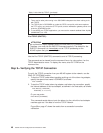
Additional host names are useful as alternative nicknames. See the examples in
Figure 23.
Host names need not be unique. When searching the host table with a duplicate
host name, the result is random. However, IP addresses have to be unique. The
uniqueness of the IP address is enforced at the time you try to add a new entry to
the host table.
Note: An IP address cannot be used as a host name.
To remove one of the additional host names, select option 2 to change the selected
host table entry. Type *BLANK over the host name to remove it.
Note: The fully qualified host name is used when sending mail between two
TCP/IP hosts.
Notice in the example that the name of AS/400 system SYSNAM890 is in the host
table too. There are several reasons to put your host name in the host table:
v You may want to use your host name when using FTP, TELNET, or PING to test
your own system’s configuration.
Work with TCP/IP Host Table Entries
System: SYSNAM890
Type options, press Enter.
1=Add 2=Change 4=Remove 5=Display 7=Rename
Internet Host
Opt Address Name
_ _______________
_ 9.4.73.211 BERN
_ 9.4.73.212 SYSNAM890
_ 9.4.73.214 MACIAN
_ 9.4.191.76 DNS
_ 9.125.87.127 SYSNAMEND.ENDICOTT.IBM.COM
_ 127.0.0.1 LOOPBACK
LOCALHOST
Figure 22. Example of a Fully Qualified Host Table Entry
Work with TCP/IP Host Table Entries
System: SYSNAM890
Type options, press Enter.
1=Add 2=Change 4=Remove 5=Display 7=Rename
Internet Host
Opt Address Name
_ _______________
_ 9.4.73.211 BERN
_ 9.4.73.212 SYSNAM890
M03
F25
MYSYSTEM
_ 9.4.73.214 MACIAN
_ 9.4.191.76 DNS
_ 9.4.73.198 SYSNAMRS
Figure 23. Multiple Host Names
Chapter 2. Configuring TCP/IP 41


















